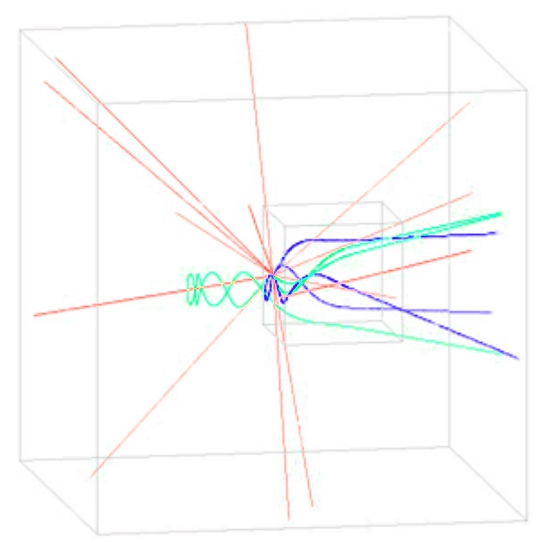Antimatter Propulsion Engine Redesigned Using CERN’s Particle Physics Simulation Toolkit
Smash a lump of matter into antimatter and it will release a thousand times more energy than the same mass of fuel in a nuclear fission reactor and some 2 billion times more than burning the equivalent in hydrocarbons.

So it’s no wonder that antimatter is the dream fuel for science fiction fans.
The problem, of course, is that antimatter is in rather short supply making the prospect of ever building a rocket based on this technology somewhat remote.
But from time to time physicists put aside these concerns and have a little fun working out how good antimatter rocket engines can be. Today it’s the turn of Ronan Keane at Western Reserve Academy and Wei-Ming Zhang at Kent State University, both in Ohio, who take a new approach to the problem with some interesting results.
First, some basic rocket science. The maximum speed of a rocket depends on its exhaust velocity, the fraction of mass devoted to fuel and the configuration of the rocket stages. “The latter two factors depend strongly on fine details of engineering and construction, and when considering space propulsion for the distant future, it seems appropriate to defer the study of such specifics,” say Keane and Zhang.
So these guys focus on the exhaust velocity–the speed of the particles produced in matter-antimatter annihilations as they leave the rocket engine.
The thrust from these annihilations comes largely from using a magnetic field to deflect charged particles created in the annihilation. These guys focus on the annihilation of protons and antiprotons to produce charged pions.
So an important factor is how efficiently the magnetic field can channel these particles out of the nozzle.
In fact, the exhaust velocity of these pions depends on two factors–their average initial velocity when they are created and the efficiency of the magnetic nozzle design.
In the past, various physicists have calculated that the pions should travel at over 90 per cent the speed of light but that the nozzle would be only 36 per cent efficient. That translates into an average exhaust velocity of only a third of lightspeed, barely relativistic and somewhat of a disappointment for antimatter propulsion fans.
All that is set to change now, however. Keane and Zhang have come up with a different set of figures with the help of software developed by CERN that simulates the interaction between particles, matter and fields of various kinds.
CERN uses this software, called GEANT4 (short for Geometry and Tracking 4), to better understand how particles behave at the Large Hadron Collider, which itself collides beams of protons and antiprotons. So it’s ideally suited to Keane and Zhang’s task.
The new work produces some good news and some bad news. First the bad. The new simulations indicate that pions produced in this way will be significantly slower than previously thought, travelling at only 80 per cent of light speed.
The good news is that the GEANT4 simulations indicate that a magnetic nozzle can be much more efficient than previously envisioned, reaching 85 per cent efficiency. That translates into an average exhaust velocity of about 70 per cent light speed. That’s much more promising. “True relativistic speeds once more become a possibility,” say Keane and Zhang.
These guys have another surprise up their sleeve. Their nozzle has a magnetic field strength of around 12 Tesla. “Such a field could be produced with today’s technology, whereas prior nozzle designs anticipated and required major advances in this area,” they say.
That will bring a smile to the face of many science fiction fans.
There is, of course, the small problem of gathering enough antimatter for a journey of any decent length. The number of antiatoms made at CERN is small enough to be countable. By one estimate, at this rate it will take a thousand years to make a single microgram of antimatter.
Keane and Zhang point out that all earlier estimates predate the PAMELA spacecraft’s discovery last year that Earth is surrounded by a ring of antiprotons and suggest that this could mined for fuel. What they don’t mention, however, is that PAMELA spotted only 28 antiprotons in two years–far less than the rate at which CERN makes them on a daily basis.
Keane and Zhang finish by noting that other fuel technologies have advanced at an exponential rate, liquid hydrogen production, for example. If antimatter manufacture turns out to follow a similar trajectory, who knows what could happen.
Interesting, entertaining and wildly ambitious–all good fun.
Ref: arxiv.org/abs/1205.2281: Beamed Core Antimatter Propulsion: Engine Design and Optimisation
Keep Reading
Most Popular
Large language models can do jaw-dropping things. But nobody knows exactly why.
And that's a problem. Figuring it out is one of the biggest scientific puzzles of our time and a crucial step towards controlling more powerful future models.
How scientists traced a mysterious covid case back to six toilets
When wastewater surveillance turns into a hunt for a single infected individual, the ethics get tricky.
The problem with plug-in hybrids? Their drivers.
Plug-in hybrids are often sold as a transition to EVs, but new data from Europe shows we’re still underestimating the emissions they produce.
Stay connected
Get the latest updates from
MIT Technology Review
Discover special offers, top stories, upcoming events, and more.